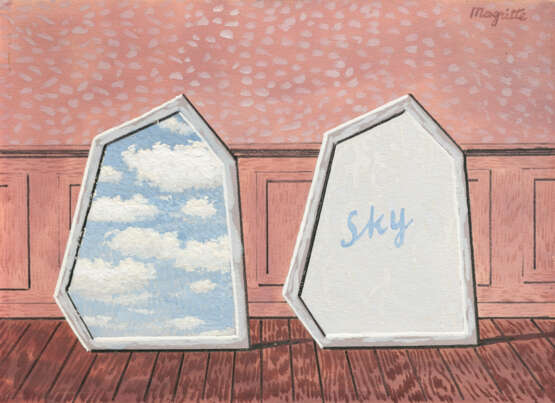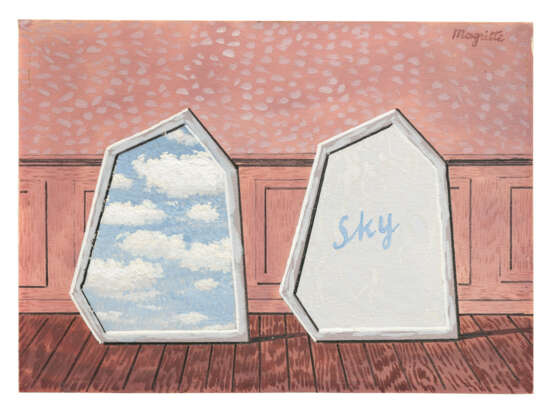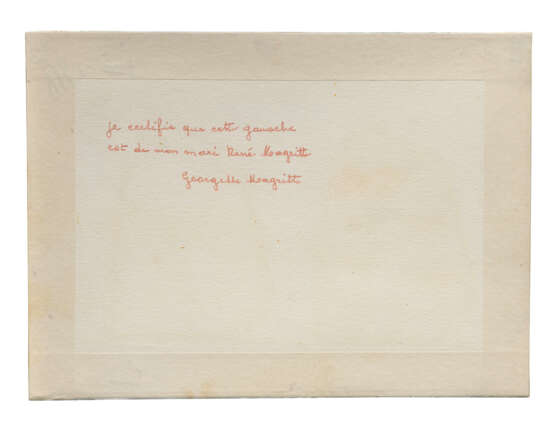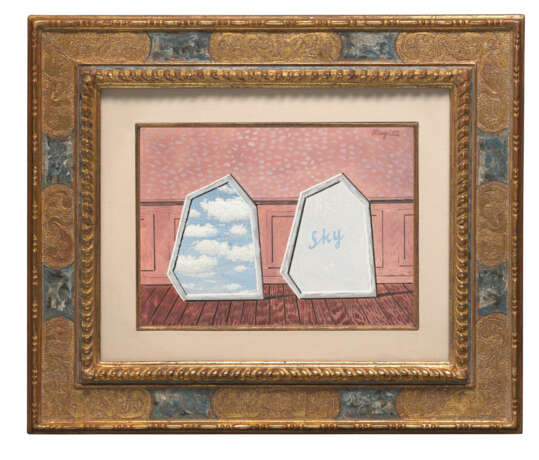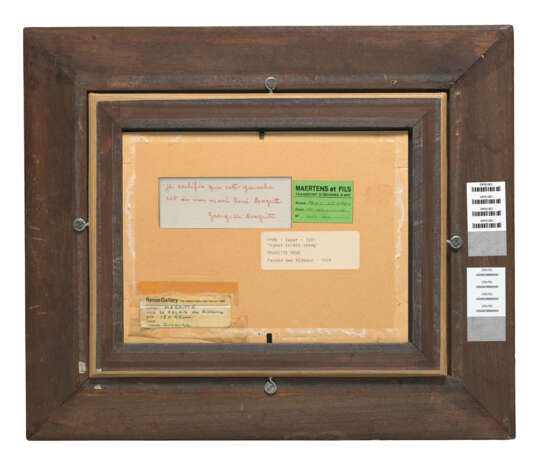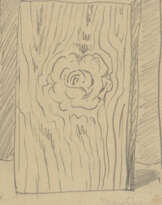ID 1053080
Lot 316 | René Magritte (1898-1967)
Estimate value
€ 500 000 – 800 000
Le Palais de rideaux
signé 'Magritte' (en haut à droite)
gouache et graphite sur papier
17.1 x 23.5 cm.
Exécuté vers 1965
signed 'Magritte' (upper right)
gouache and pencil on paper
6 ¾ x 9 ¼ in.
Executed circa 1965
Provenance
Patricia Specter.
Byron Gallery, New York, (avant 1968).
Vente, Sotheby Parke Bernet & Co., Londres, 1er décembre 1976, lot 219.
Galerie Isy Brachot, Paris (en 1977 et jusqu'en 1981).
Madame Krebs, Bruxelles.
Acquis auprès de celle-ci par le propriétaire actuel dans les années 1980.
Literature
'Lettre de Magritte à Torczyner, 3 février 1967', in H. Torczyner, L'Ami Magritte, Correspondance et souvenirs, Anvers, 1992, p. 383-384, no. 503.
D. Sylvester, éd., René Magritte, Gouaches, Temperas, Watercolours and Papiers Collés, 1918-1967, Anvers, 1994, vol. IV, p. 279, no. 1574 (illustré).
Exhibited
Bruxelles, Palais des Beaux-Arts, Foire d'Art, février 1977 (daté '1936').
Paris, Grand Palais, Foire Internationale d'Art Contemporain, octobre 1977, no. 5 (illustré; daté '1936').
Bruxelles, Galerie Isy Brachot, Mini-Maxi III, Huiles et sculptures de petits formats, décembre 1976-janvier 1977 (daté '1936').
Paris et Bruxelles, Galerie Isy Brachot, Magritte, janvier-mai 1979, no. 7 (illustré en couleurs; titré 'Le Palais de rideaux III'; daté '1936').
Further details
« La gouache ‘Le Palais des Rideaux’ est bien authentique – si j’en suis l’auteur et je le crois car, je me souviens avoir changé le mot ciel en ‘Sky’. Il arrive parfois que ma signature puisse mettre des experts compétents dans l'embarras. En cela, je crois obliger la science de l'expertise à moins d'assurance qu'elle en témoigne, quelles que soient les contradictions qui mettent souvent les experts en posture de combat. »
'Lettre de Magritte à Torczyner, 3 février 1967', in H. Torczyner, L'Ami Magritte, Correspondance et souvenirs, Anvers, 1992, p. 383-384, no. 503.
La présente œuvre est intimement liée aux célèbres « tableaux-mots » que réalisa le père du surréalisme belge René Magritte. Si Magritte produit la majeure partie de cet ensemble entre 1927 et 1931, il se prêtera ponctuellement au jeu tout au long de sa vie, comme en témoigne le présent Palais de rideaux, exécuté vers 1965. Ces recherches, que le peintre initie dès la fin des années 1920, visent à démontrer que ni les mots, ni les images ne sont réellement ce par quoi l'on les désigne, et que le sens des choses dépend donc de conventions arbitraires. Ici, l’artiste joue sur deux manières distinctes de description du ciel : en ayant recours au visuel, dans la partie gauche de la présente œuvre, et ensuite en ayant recours au langage, dans la partie droite de l’œuvre. La présente œuvre témoigne donc de l’intérêt fort que Magritte porte aux systèmes de représentation plastiques et linguistiques et aux fondements aléatoires du langage constitue le thème central de ses tableaux-mots. Selon Suzi Gablik, Magritte s'attache ainsi à « mettre en lumière la confusion et la simplification hâtive qui sont si profondément ancrées dans nos habitudes linguistiques qu'elles passent inaperçues » (S. Gablik, Magritte, New York, 1985, p. 124). Magritte joue ici sur l’ambiguïté possible entre notre perception des signes associés à ces objets, et leur existence dans le monde tangible. L'artiste se plaît à imaginer des mariages fortuits entre des mots et des images quelconques, afin de souligner le rapport hasardeux qui existe entre tout objet et son nom, dans la mesure où le lien entre un terme et la chose qu'il désigne n'existe qu'en vertu de normes sémantiques. En présentant les mots dans un contexte visuel inédit et inattendu, Magritte subvertit le sens qui leur est habituellement attribué, pour mettre à nu les principes réducteurs et trompeurs qui sous-tendent nos formes de communication et notre langage de tous les jours.
Dans la présente œuvre, Magritte aborde l’un des thèmes les plus réccurent de son œuvre, le ciel. Au monde clos d’un intérieur domestique familier, dont le parquet et les boiseries sont emblématiques de ses huiles des années vingt, Magritte oppose ici l’illimité, l’insondable et l’inhabitable que nous évoque à la ,fois la représentation visuelle du ciel et l’idée véhiculée par le mot ‘Sky’. Paul Nougé, ami de Magritte, écrivit à propos de ce sujet : « Le ciel. On n'a pas encore poussé assez loin l'analyse de cet objet considérable. Il faudrait écrire une histoire humaine du ciel pour démêler le curieux méli-mélo séculaire d'impressions, de stimulations et d'illuminations naïves (L'éternel silence...), de physique plus ou moins exacte, de constructions religieuses bancales. Dans ce domaine, les révélations des peintres ont été rares. Et banales, il suffit d'ouvrir n'importe quelle encyclopédie de la peinture. Magritte, cependant, est l'exception" (P. Nougé, Les Points sur les signes, 1948).
"The gouache 'Le Palais des Rideaux' is indeed authentic - if I am the author, and I believe I am, because I remember changing the word 'ciel' to 'Sky'. It sometimes happens that my signature can embarrass competent experts. In this way, I believe I am forcing the science of expertise to be less assertive than it is, whatever the contradictions that often put experts in a combat posture."
Letter from Magritte to Torczyner, 3 February 1967, in H. Torczyner, L'Ami Magritte, Correspondance et souvenirs, Antwerp, 1992, pp. 383-384, no. 503.
The present gouache is closely linked to the famous « tableaux-mots » created by René Magritte, the father of Belgian Surrealism. Although Magritte produced the majority of these paintings between 1927 and 1931, he also played the game with words and images from time to time throughout his life, as can be seen in the present Palais de rideaux, painted circa 1965. This research, which the painter began in the late 1920s, aimed to demonstrate that neither words nor images are really what we make them out to be, and that the meaning of things therefore depends on arbitrary conventions. Here, the artist plays with two distinct ways of describing the sky: first by using the visual, in the left-hand part of the work, and then by using the language, in the right-hand part. The present work thus testifies to Magritte's strong interest in plastic and linguistic systems of representation, and the random foundations of language is the central theme of his « tableaux-mots ». According to Suzi Gablik, Magritte's aim was to "highlight the confusion and hasty simplification that are so deeply rooted in our linguistic habits that they go unnoticed" (S. Gablik, Magritte, New York, 1985, p. 124). Magritte plays here on the possible ambiguity between our perception of the signs associated with these objects and their existence in the tangible world. The artist likes to imagine fortuitous combinations between words and images of any kind, in order to underline the hazardous relationship that exists between any object and its name, insofar as the link between a term and the thing it designates exists only by virtue of semantic norms. By presenting words in a new and unexpected visual context, Magritte subverts the meanings usually attributed to them, exposing the reductive and misleading principles that underlie our everyday forms of communication and language.
In the present gouache, Magritte tackles one of the most recurrent themes in his oeuvre : the sky. In contrast to the enclosed world of a familiar domestic interior, whose wooden floor and wooden panels are emblematic of his oil paintings of the 1920s, Magritte here contrasts the limitless, unfathomable and uninhabitable evoked by both the visual representation of the sky and the idea conveyed by the word 'sky'. Paul Nougé, a friend of Magritte's, wrote of this subject: "The sky. We have not yet gone far enough in analyzing this considerable object. One would have to write a human history of the sky to untangle the curious, age-old jumble of impressions, stimuli and naive illuminations (L'éternel silence...), of more or less exact physics, of shaky religious constructions. In this field, the revelations of painters have been rare. And they are commonplace - just open any encyclopedia of painting. Magritte, however, is the exception" (P. Nougé, Les Points sur les signes, 1948).
| Artist: | René Magritte (1898 - 1967) |
|---|---|
| Applied technique: | Gouache |
| Artist: | René Magritte (1898 - 1967) |
|---|---|
| Applied technique: | Gouache |
| Address of auction |
CHRISTIE'S 9 Avenue Matignon 75008 Paris France | ||||||||||||||
|---|---|---|---|---|---|---|---|---|---|---|---|---|---|---|---|
| Preview |
| ||||||||||||||
| Phone | +33 (0)1 40 76 85 85 | ||||||||||||||
| Fax | +33 (0)1 40 76 85 86 | ||||||||||||||
| Conditions of purchase | Conditions of purchase | ||||||||||||||
| Shipping |
Postal service Courier service pickup by yourself | ||||||||||||||
| Payment methods |
Wire Transfer | ||||||||||||||
| Business hours | Business hours
|
